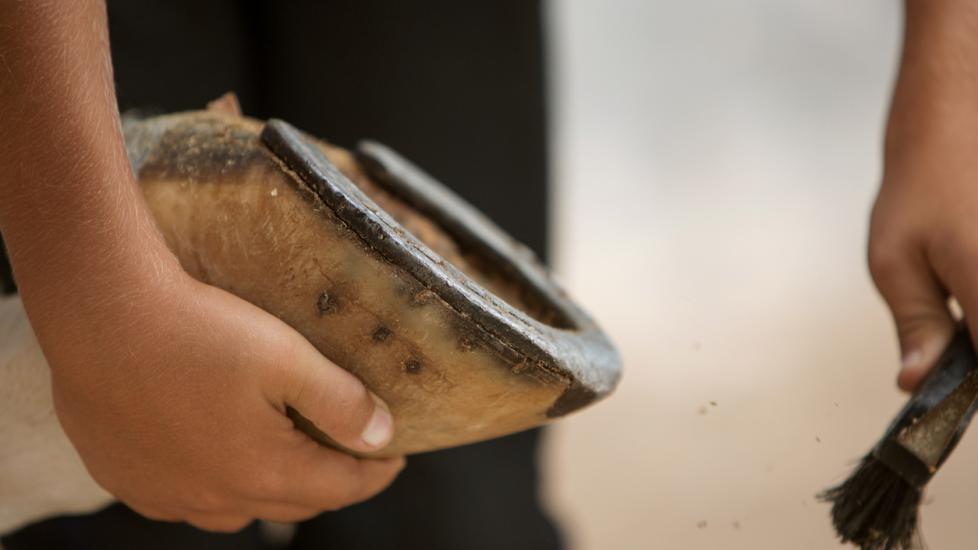White Line Disease in Horses
What Is White Line Disease in Horses?
White line disease in horses is a disease localized to the hoof. Also known as “seedy toe” because of its appearance, it is a common disease that can vary in severity affecting horses of any age, sex or breed. Though it occurs most often at the toe, it can occur in the heel or quarter regions of the hoof. One or multiple hooves may be involved.
The process of white line disease is poorly understood, but it starts with a separation of the hoof wall. The hoof wall consists of three layers:
-
the stratum externum (external layer)
-
the stratum medium (the middle layer)
-
the stratum internum (the inner layer)
The separation that occurs in white line disease is between the middle and inner layers. Once the stratum medium is compromised, bacteria and fungi can invade and further break down the soft tissue. White line disease can vary in how far it spreads and should be inspected by your farrier during normal routine hoof care.
Symptoms of White Line Disease in Horses
Horses suffering from white line disease may exhibit the following signs:
-
Lameness in some cases (based on severity)
-
Widening of the sole to wall junction
-
Inner surface of the hoof wall looks mealy, powdery, or “seedy”
-
Outer surface looks normal
-
-
Hollow sound when hoof wall tapped over affected region
-
Small area or large section of hoof wall
Causes of White Line Disease in Horses
White line disease is most commonly caused by:
-
Poor quality hoof wall
-
Poor hoof wall conformation leading to excessive mechanical stress
-
Split or crack in the hoof wall
-
Environmental condition with too much moisture, i.e., continuous wet pasture
-
Drought conditions producing excessively dry feet and predisposing to cracks
-
Horses with chronic laminitis
-
Negligent foot care, e.g., hoof wall grown too long
Diagnosing White Line Disease in Horses
A diagnosis of white line disease can often be made by visual inspection of the white line, assisted by a probing instrument. This will reveal a cavity with separation between the middle and inner layers of the hoof. The cavity can be either dry or filled with necrotic debris (dead and decaying cells and tissue), and may also involve a bacterial or fungal infection. Often, the horse will have tender soles as noted with hoof testers and the sole will become increasingly flat. Radiographs are used to determine the full extent of the separation of the hoof wall and to evaluate for any underlying conditions like laminitis.
Treatment of White Line Disease in Horses
In order to treat white line disease, your veterinarian will need to remove the outer hoof wall that has separated from the underlying laminae. This can be done with hoof nippers, a hoof knife, or a motorized tool. Any cracks or crevices in the external laminae should be smoothed with a Dremel burr. The exposed sensitive laminae will need to be treated for any infections by applying topical iodine daily for a week or until the exposed laminae are dry and healthy.
Therapeutic shoeing is also imperative to treatment. A heart bar shoe redistributes weight-bearing forces to the frog and lower region of the foot and away from the damaged and weakened area. Alternatively, a wide-webbed shoe could be applied to protect the treated area and the thinned wall. In the case of large defects, where a traditional shoe cannot be nailed on, a wooden on glue-on shoe may be used.
Recovery and Management of White Line Disease in Horses
A full recovery will depend on proper management of the defect until the hoof wall has completely grown out. This includes keeping the hoof clean and dry. If the horse responds to the initial treatment and environmental conditions improve, the prognosis is good.
Treating and correcting any predisposing factors is critical for long-term care. Unfortunately, horses with genetically poor hoof quality or that have chronic laminitis will often have white line disease reoccur.
White Line Disease in Horses FAQs
How serious is white line disease?
Any disease of the equine hoof can quickly escalate from non-serious to severe.
Can a horse recover from white line disease?
With proper care, a horse with white line disease can make a full recovery, barring severe underlying conditions like chronic laminitis.
References
-
O’Grady, S. Veterinary Information Network. A fresh look at white line disease. 2011.
-
Hadden, W. Horseman’s Veterinary Encyclopedia. Lyons Press. 2005.
-
Smith, B. Large Animal Internal Medicine. 4th ed. Mosby Elsevier. 2009.
Featured Image: iStock.com/Natalia Saudi
